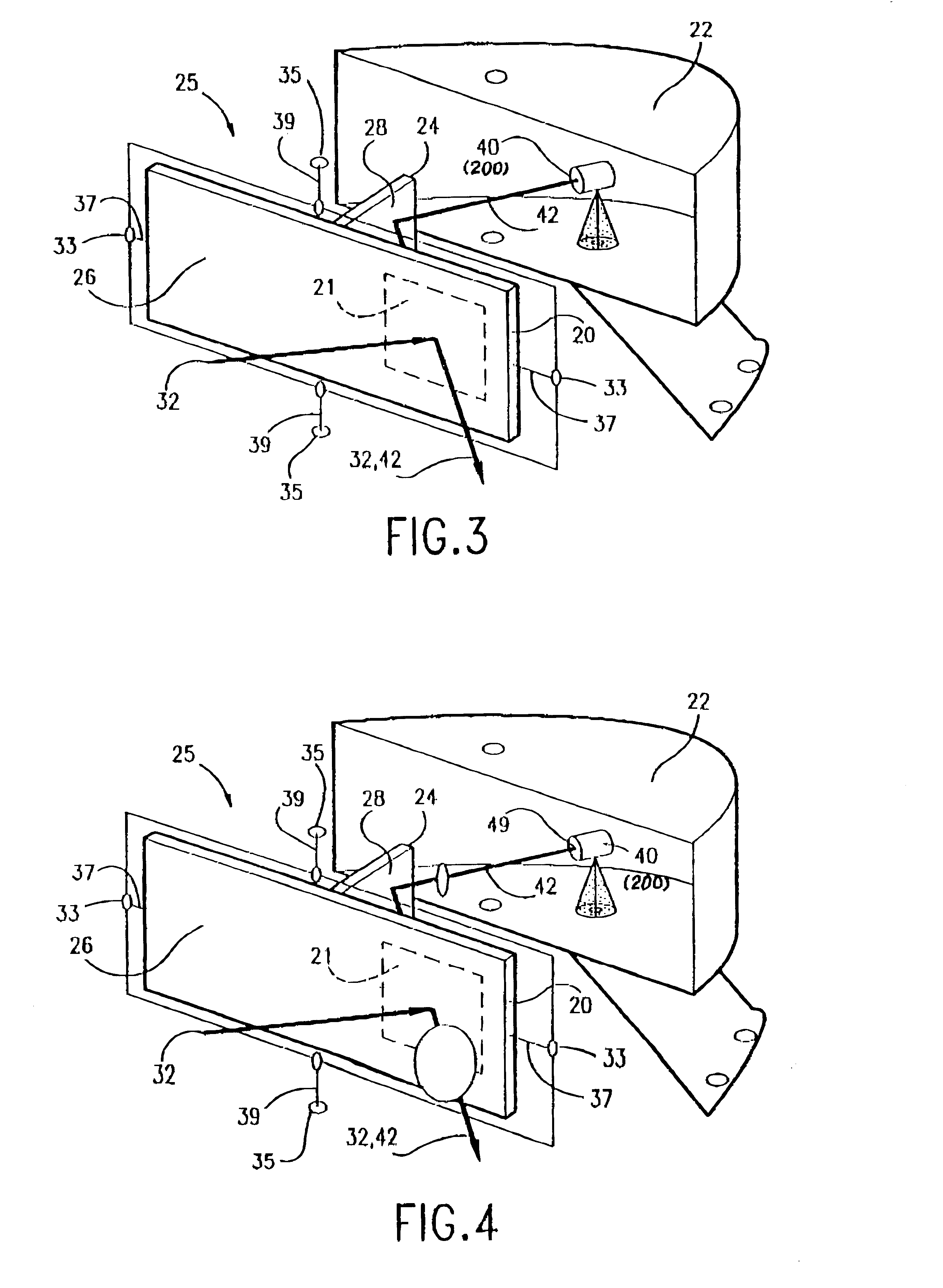Method and apparatus for determining the location of an occupant of a vehicle
a technology for determining the location of an occupant and a vehicle, which is applied in the direction of height/levelling measurement, electric devices, lighting support devices, etc., can solve the problems of wide "blind spots" or "blind zones" on either side of the vehicle, limiting the view to either side, and affecting the alignment of azimuth angles
- Summary
- Abstract
- Description
- Claims
- Application Information
AI Technical Summary
Benefits of technology
Problems solved by technology
Method used
Image
Examples
first embodiment
A summarized above, the first embodiment involves use of one or more fixed light sources emitting a respective light beam pair that is deflected by a reflector until the light beam pair is visible to the driver whereupon the driver's eye location may be derived. In a first variation illustrated in reference to FIGS. 1-5, each light source and reflector are associated with a vehicle sideview mirror. In a further variation illustrated in reference to FIGS. 11-15, a single light source and reflector are associated with a vehicle rearview mirror.
In the first variation of the first preferred embodiment illustrated in FIGS. 1-5, the a 'priori mathematical determination of the nominal blind spot direction with respect to the aforementioned mirror reference point on the mirror surface is used to mount a narrow wavelength light source emitting a light beam pair in a fixed relationship with respect to the vehicle left and / or right sideview mirror housing. When properly mounted in the mirror h...
second preferred embodiment
Before discussing the second variation of the first embodiment, attention is directed to the first variation of the second preferred embodiment and FIGS. 6 -8 wherein a light source 40 is associated with at least one of the vehicle sideview mirrors, as in the first variation of the first embodiment. In this second embodiment, the driver's manipulation of the joystick control 54 of FIG. 7 now directly adjusts the LED 40 (or other light source) light beam 42 direction, not the pitch and azimuth of the sideview mirror 20. In the system illustrated in FIGS. 6 and 7, the LED 40 is mounted for movement about pitch and azimuth axes within a sideview mirror assembly 27 in relation to a selectively light transmissive region 21 of the mirror 20. It should be noted that in a second variation of the second embodiment illustrated in FIGS. 9 and 10 and described in detail below, the LED 40 is mounted for movement about pitch and azimuth axes at a mounting point within the vehicle cabin. In either...
second embodiment
FIG. 6 shows a simplified mirror subassembly 25 of the mechanical components of this first variation of the second preferred embodiment of the invention with the LED 40 incorporated into the mirror subassembly 25 as in the embodiment depicted in FIG. 5. Note in FIG. 6, that the LED 40 is mounted on a set of LED pitch and azimuth gimbals 43 and 45, respectively, rather than directly mounted on the mirror housing 22. Also note that the LED beam 42 is directed toward the driver through the selectively light transmissive region 21 and not reflected off an auxiliary mirror. The latter is not necessary and would only complicate the mathematics involved in this The outer, LED azimuth gimbal 45 permits rotations of the LED 40, and hence LED light beam 42, about a vertical 49 to adjust for driver fore-aft seat position. The inner, LED pitch gimbal 43 allows for the LED 40 to be tilted up or down with respect to the driver's eye level about a horizontal axis 47.
In this first variation of the...
PUM
 Login to View More
Login to View More Abstract
Description
Claims
Application Information
 Login to View More
Login to View More - R&D
- Intellectual Property
- Life Sciences
- Materials
- Tech Scout
- Unparalleled Data Quality
- Higher Quality Content
- 60% Fewer Hallucinations
Browse by: Latest US Patents, China's latest patents, Technical Efficacy Thesaurus, Application Domain, Technology Topic, Popular Technical Reports.
© 2025 PatSnap. All rights reserved.Legal|Privacy policy|Modern Slavery Act Transparency Statement|Sitemap|About US| Contact US: help@patsnap.com



